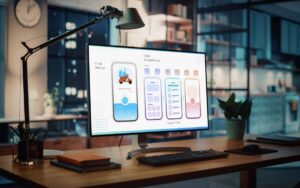In the digital realm, where the interplay of design and user experience can dictate the success of an application or website, the concept of dark mode design has emerged as a beacon of innovation. As more users demand interfaces that cater to their viewing preferences, especially under varied lighting conditions, dark mode design has transitioned from a mere aesthetic choice to a significant user interface consideration.
This comprehensive guide delves into the essence of dark mode design, distinguishing it from dark themes, exploring its benefits, and offering insights into crafting user interfaces that seamlessly support this feature. It will also discuss a comprehensive online UX/UI program that can help aspiring designers learn how to create the best user interfaces.
What is Dark Mode Design?
Dark mode design is a user interface (UI) theme that employs a dark color palette primarily for backgrounds and lighter colors for text and other elements. This design approach inversely contrasts the traditional light mode, where dark text is displayed on a light background. Dark mode aims to reduce glare and the amount of light emitted by device screens, creating a more comfortable viewing experience in low-light conditions. It has gained popularity across various platforms and devices, from operating systems to mobile apps and websites.
Also Read: How to Design a User-Friendly Interface?
What is the Difference Between Dark Mode Design and Dark Theme?
While often used interchangeably, “dark mode design” and “dark theme” refer to slightly different concepts. Dark mode design encompasses the entire process of designing an interface that incorporates a dark aesthetic, focusing on usability, accessibility, and aesthetics. It involves thoughtful consideration of color contrast, typography, and visual hierarchy to ensure readability and user comfort.
On the other hand, a dark theme is a specific implementation of dark mode design. It’s a selectable option within software that switches the visual appearance from a light background to a dark one. Thus, while a dark theme is a product of dark mode design, the design process encompasses broader considerations than the color scheme.
Benefits of Dark Mode Design
Dark mode design offers several advantages, making it a favored choice among users and designers. These benefits include:
- Reduced Eye Strain: Dark backgrounds are easier on the eyes in low-light conditions, reducing eye strain and discomfort.
- Battery Conservation: On OLED and AMOLED screens, displaying black pixels consumes less power, extending battery life.
- Visual Appeal: Many users prefer dark mode for its modern and sleek look, which can enhance the interface’s aesthetic appeal.
- Less Blue Light Exposure: Reducing exposure to blue light, especially during evening hours, can improve sleep quality.
Accessibility Benefits of Dark Mode
Accessibility is a crucial consideration in design, and dark mode can significantly enhance visual ergonomics for users with specific visual impairments. It can:
- Reduce glare, benefiting users with photophobia or light sensitivity.
- Improve readability for users with certain types of dyslexia who find light text on a dark background easier to process.
- Offer a comfortable viewing experience for users with low vision by improving contrast.
Also Read: A Guide to Improving and Measuring User Experience
How to Design User Interfaces That Support Dark Mode
Designing for dark mode requires more than inverting colors. Here are key considerations:
- Contrast: Ensure adequate contrast ratios for readability while avoiding overly bright colors that can cause glare.
- Colors: Choose a palette that reduces eye strain; deep blues or greys are often preferable to pure black backgrounds.
- Typography: Opt for fonts that remain legible in dark mode, possibly adjusting weight and spacing to maintain readability.
- Images and Icons: Adjust the brightness and contrast of images and icons to fit dark backgrounds without losing detail or vibrancy.
Pros and Cons of Dark Mode Design
Pros
- It enhances visual ergonomics, especially in low-light environments
- It can save battery life on certain screen technologies
- It offers a visually appealing alternative for users and can increase engagement
Cons
- It’s not universally optimal; some users find dark mode less readable in bright conditions
- It can pose challenges in ensuring accessibility and legibility for all text and elements
- It may require additional design and development resources to implement effectively
Best Practices for Dark Mode Design
To maximize the effectiveness and appeal of dark mode design, follow these best practices:
- Provide User Choice: Allow users to toggle between light and dark modes easily.
- Test Extensively: Ensure all elements are legible and accessible in both modes.
- Use True Black Sparingly: Opt for dark greys instead of pure black to reduce eye strain and enhance depth.
- Adapt Content: Modify images, icons, and other elements to fit the dark theme without losing quality.
Also Read: UI/UX Designer Salary: What Can You Expect?
Examples of Dark Mode Design
Many popular applications and websites offer dark mode options, showcasing how it can be effectively implemented:
- Social Media Platforms: Apps like Twitter and Instagram feature dark modes that reduce glare during nighttime scrolling.
- Productivity Software: Tools like Slack and Google Docs offer dark themes to enhance focus and reduce eye strain during extended use.
- Operating Systems: iOS and Android provide system-wide dark mode settings, influencing app developers to adopt dark mode in their designs.
Wrapping Up
Dark mode design is more than just a trend; it’s a thoughtful approach to user interface design that prioritizes user comfort, accessibility, and aesthetic appeal. As digital device usage continues to rise, the demand for user-friendly and eye-friendly interfaces becomes increasingly critical. Dark mode offers a solution that meets these needs and brings a fresh, modern look to the digital experience.
The transition to dark mode design requires a nuanced approach, understanding that it’s not a one-size-fits-all solution. To create beautiful and functional interfaces in dark mode, designers must consider various factors, including user context, device type, and environmental lighting. Furthermore, offering users the choice between light and dark modes empowers them to select the option that best suits their preferences and needs, enhancing the overall user experience.
Accessibility should remain a paramount concern when designing for dark mode. By ensuring that interfaces are accessible in light and dark modes, designers can cater to a broader audience, including those with visual impairments. This inclusivity broadens the user base and reflects a commitment to designing digital products that serve and respect all users.
The adoption of dark mode design by major platforms and applications underscores its popularity and practicality. However, its implementation is not without challenges. Designers must carefully balance contrast, color, and legibility to avoid common pitfalls associated with dark backgrounds. Through meticulous design and testing, these challenges can be overcome, resulting in stunning and user-friendly interfaces. Aspiring designers can gain fundamental and advanced skills to tackle these challenges through a UX/UI bootcamp.
As we look to the future, dark mode design is poised to evolve further, influenced by advancements in screen technology, user interface design trends, and ongoing research into digital well-being. Its growing acceptance and implementation across the digital landscape highlight its effectiveness in enhancing the user experience while addressing the practical needs of device usage in various lighting conditions.
In conclusion, dark mode design represents a significant shift in how we approach digital interfaces, emphasizing user comfort, energy efficiency, and visual appeal. By adhering to best practices and focusing on accessibility, designers can create dark mode experiences that are aesthetically pleasing but also inclusive and functional for a wide range of users. As dark mode continues to gain popularity, its thoughtful implementation will remain crucial in crafting digital environments that are both engaging and comfortable for all users, day or night.
You might also like to read:
How to Become a UX/UI Designer: A Comprehensive Guide
UX/UI Designer Career Path: A Comprehensive Guide
All About UX/UI Design Principles
Accessibility in UX Design: A Definitive Guide
Career Prep: Linux Interview Questions for UX/UI Design Professionals






